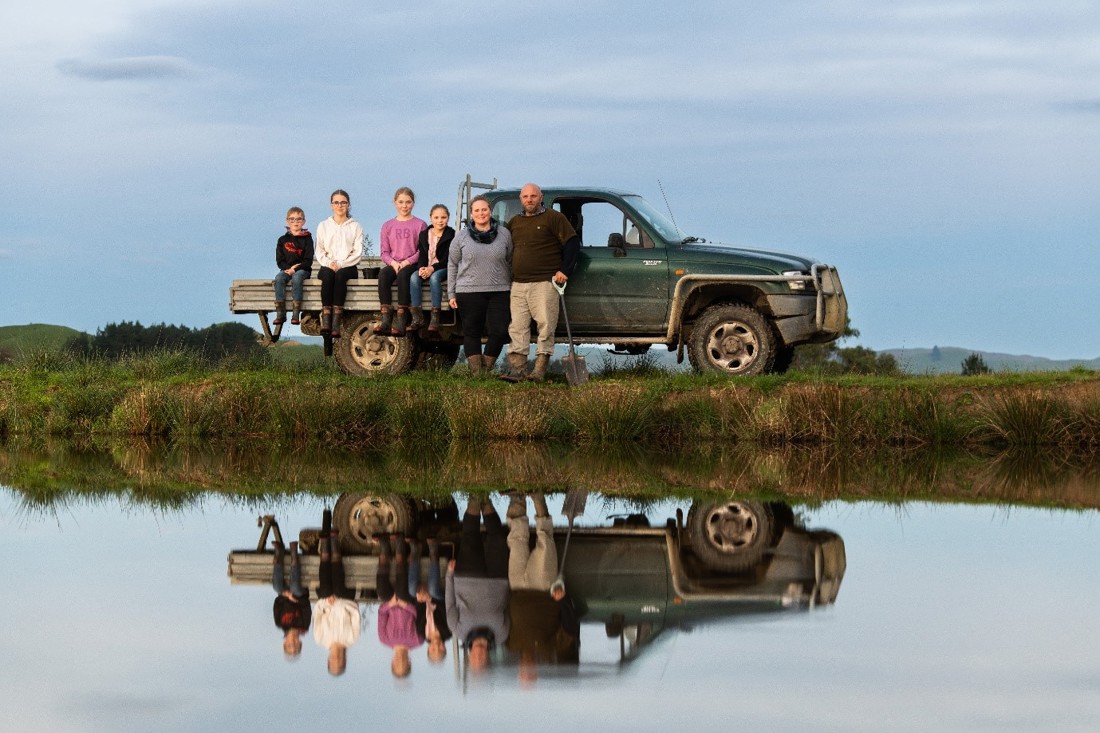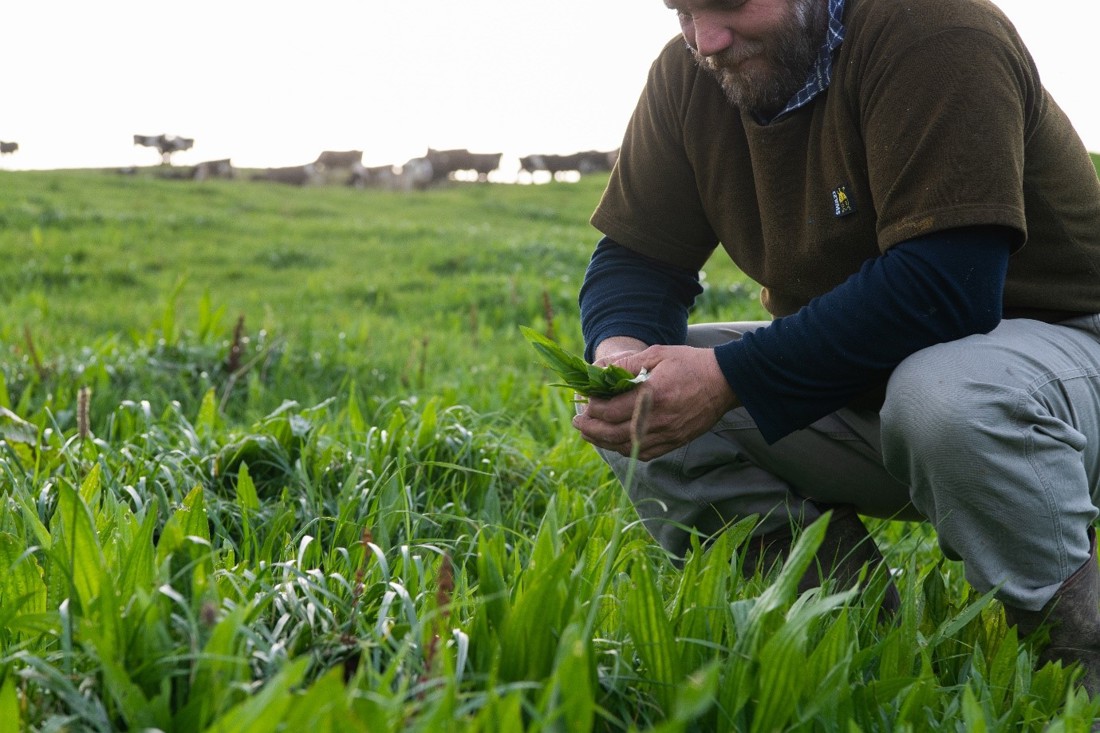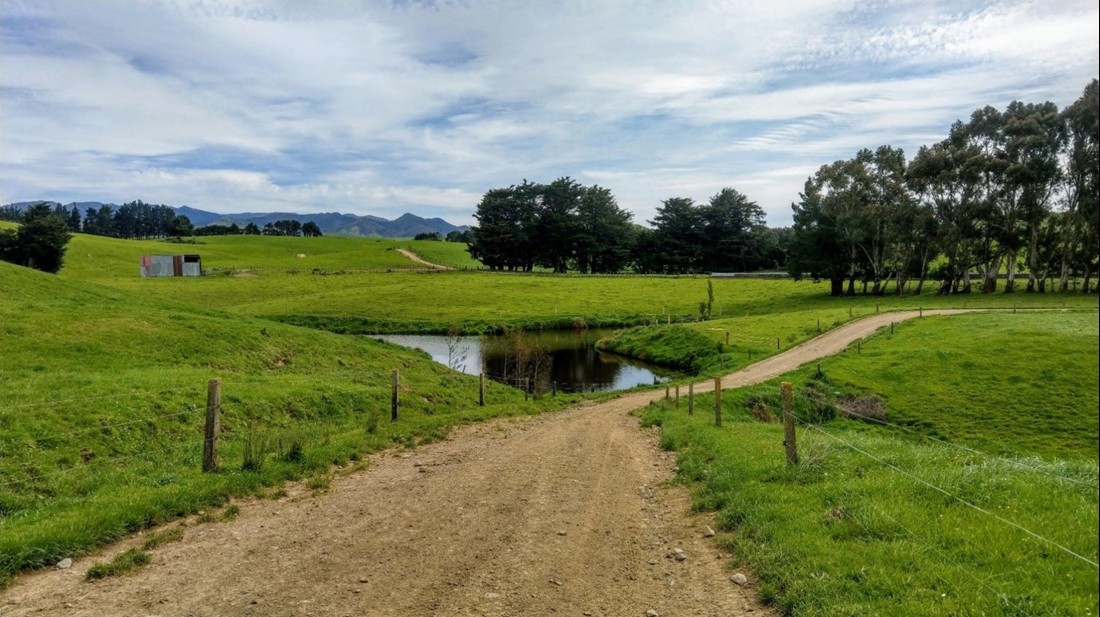Plantain partner farm, Aaron and Jo Passey (Dannevirke)
6 min read
The page provides a real-life example on how to grow plantain as part of the dairy farm management and its environmental benefits. Aaron and Jo Passey own and operate a 129 effective hectare dairy farm 14 km north of Dannevirke. During their first year using plantain, the Passey’s cultivated and drilled three paddocks into plantain crop at 12 kg Ecotain plantain seed per hectare. Now, Ecotain plantain is present on 63% of the farm, making up an average of 10% of the pasture sward. So far, the Passey’s have successfully reduced N-loss by 5% on their farm.
Using plantain has resulted in a 5% N-loss for the Passey’s so far, as modelled in Overseer and based on an average of 10% plantain in the pasture sward.
Aaron and Jo were actively involved in the Tararua Plantain project from 2019 and are now part of the Plantain Potency and Practice partner farm project. As a partner farm, Te Angi will continue to be monitored until 2027. Ecotain plantain is present on 63% of the farm, making up an average of 10% of the pasture sward.
Following the success of their first year of using plantain, the Passey’s have identified how to successfully incorporate plantain into their farm system using pasture mixes and straight plantain stands.

Aaron and Jo Passey with their family.
Aaron and Jo Passey own and operate Te Angi dairy farm, a 129 effective hectare dairy farm 14 km north of Dannevirke. The Passey’s aim to operate a low-cost, high-profit system with a focus on reducing debt and have been successfully incorporating plantain into their farm system since 2019.
Farm size (effective)
129ha
Soil class
Brown (moderately well-drained)
Topography
Flat to rolling
Annual rainfall
1,555mm/year
Average annual temperature
12 degrees C
Herd size and breed
300 Friesian-cross
Stocking rate
2.3 cows/effective ha
Milksolids production (4-year average)
321 kg MS/cow
Milksolids production (4-year average)
697 kg MS/ha
Farm system class
System 3
Purchased feed
80 t DM maize silage or 80 t PKE (price dependent)
“When we saw the case study modelling for our farm showing plantain compared with other mitigation strategies to reduce N-loss, we could see it was a viable N-loss tool we could use.
Aaron Passey, Farm Owner
Modelling for the Passey’s farm showed that combining use of plantain across 20% of the farm, with changes to the existing cropping regime, enabled the Passey’s to meet their target N-loss reduction with only a 0.2% reduction in farm profit. Under the Alternative Consent Pathway in the Horizons Regional Council Plan Change 2 (PC2), Te Angi is required to reduce its N-loss from 37 to 28 kg N/ha/year.
Three scenarios were modelled for Te Angi to achieve the target N-loss while maintaining cow numbers and production.
Scenario 1: No winter oats
Scenario 2: No cereal silage
Scenario 3: 20% plantain, no crop
All three scenarios require 90-100 t DM of maize silage, 120 t DM grass silage and 100 bales of hay to fill feed deficits. The scenarios have been modelled in Farmax to check feasibility.
Table 1 shows the impact of these three scenarios on a range of metrics, including nitrogen leached and operating profit. Combining the removal of the crops with addition of plantain (at 20% of the sward) enabled the target N-loss reduction to be met while almost maintaining farm profit.
Table 1. Modelled N-loss scenarios for Te Angi Farm
| Base (2020/21 season) |
Scenario 1 | Scenario 2 | Scenario 3 | |
| Production (kg MS/year) | 92,000 | 92,000 | 92,000 | 92,000 |
| Total N loss (kg N/year) | 6,947 | 6,452 | 6,144 | 5,265 |
| N leached (kg/ha/year) | 37 | 34 | 33 | 281 |
| N surplus (kg/ha/year) | 131 | 132 | 134 | 137 |
| Purchased N surplus (kg/ha/year) | 76 | 79 | 75 | 76 |
| Operating profit ($/ha)2 | $2,341 | $2,309 (-1.3%) | $2,382 (+1.8%) | $2,336 (-0.2%) |
| Methane (t CO2 eq./ha) | 4.89 | 4.92 | 4.91 | 4.96 |
| Nitrous oxide (t CO2 eq./ha) | 1.56 | 1.56 | 1.57 | 1.54 |
1Result based on a target level of 20% plantain.
2Modelled in Farmax, based on DairyBase data.
During their first year using plantain, the Passey’s cultivated and drilled three paddocks into plantain crop at 12 kg Ecotain plantain seed per hectare. Further paddocks were broadcasted with 6 kg Ecotain seed per hectare or had plantain included in the mixed sward.
Following the success of those paddocks, the Passey’s now typically incorporate plantain both in straight stands and in new pasture mixes as part of their regrassing programme. The Passey’s standard regrassing mix includes Ecotain at 4-5 kg/ha, white clover at 4 kg/ha and ryegrass seed at anywhere from 20-32 kg/ha, depending on the type of ryegrass being used.
The Passey’s also broadcast coated seed across the farm (at 8-12 kg/ha), focusing on damaged paddocks with obvious areas of bare ground. Currently plantain is present across 63% of the farm, making up an average of 10% of the pasture sward.
Being part of the plantain partner farm network has provided opportunities to learn from other farmers and to take home practices that suit the Passey’s farm system.
We are going to start trying lower broadcasting rates after we have seen how it works in other regions.
Aaron Passey, Farm Owner
The straight plantain swards have offered an excellent summer feed source, replacing turnips in their system. The Passey’s found turnips didn’t grow particularly well on their farm, typically yielding around 8-10 t DM/ha. While the typical summer yield of a straight plantain sward in the Tararua area is around 5 t DM/ha, this is a more reliable, multi-graze crop and switching the turnips for plantain has also contributed towards reducing N-loss from the farm.
The Passey’s have found that there is very little specific management needed for plantain. While they try and minimise pugging and treading damage in plantain paddocks when its wet, aside from this the Passey’s treat plantain paddocks just as they do other paddocks on the farm.
In their spring sown pure plantain swards, the Passey’s use a late-autumn herbicide application of T-Max and Sequence, followed by a repeat of the same mix in early-autumn the following year. Mixed swards containing plantain are spot sprayed for any problem weeds.


Now’s the perfect time to check in, plan, and set up for a strong season. We’ve pulled together smart tips and tools to help you stay ahead all winter long.
Whether you prefer to read, listen, or download handy guides, we’ve got you covered with trusted tools to support your journey every step of the way.